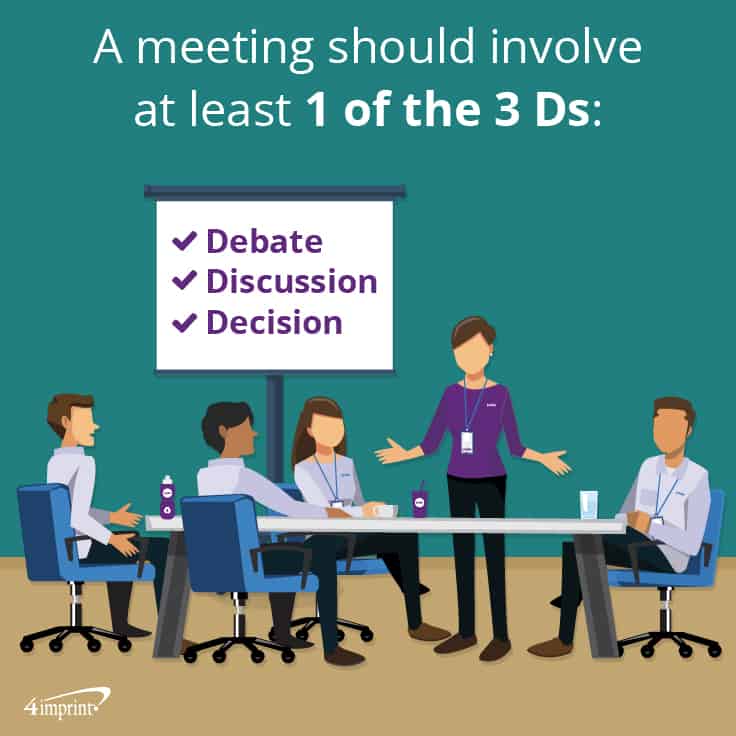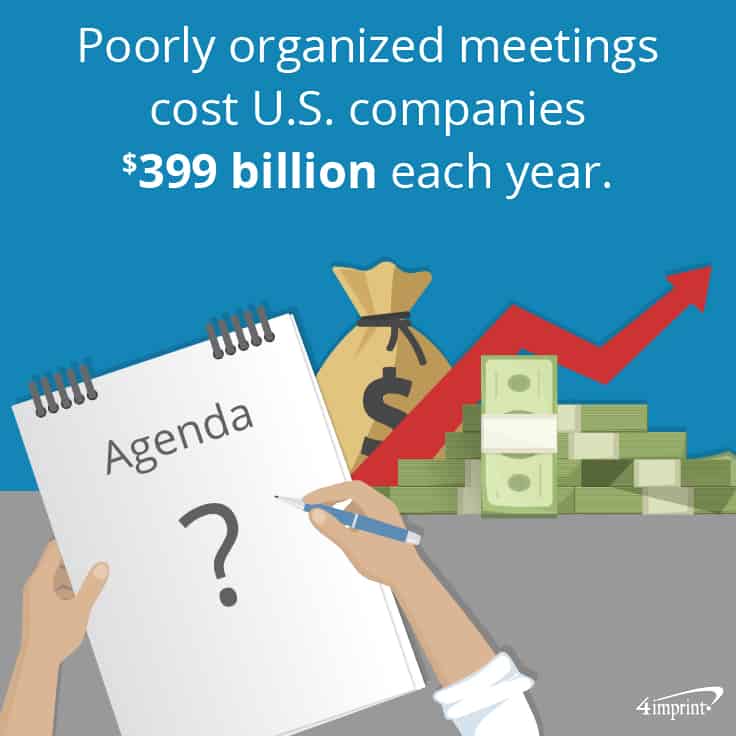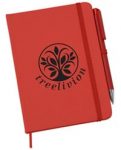Although modern in-office planning and communication can often be accomplished via email, instant messaging and one-on-one discussion, there are times when the best way to get everyone on the same page is to get them in the same room. If you’re looking for ways to maximize efficiency at your important gatherings—whether they’re all-day annual meetings or weekly one-hour sales discussions—we’ve got tips and meeting giveaways that that will help you hold more productive meetings.
In this edition of our Blue Papers®, we’ll talk about the benefits of a great meeting, how to know when a meeting is needed and how to make your meetings go smoothly.
Know when to hold a meeting

One of the best ways to make the most of the meeting is to first determine whether a meeting is even necessary. The majority of meetings are only needed if they will involve one or more of the three Ds:
- Debate: Brainstorming sessions and other forums that involve bringing up, thinking about and determining the merits of ideas.
- Discussion: Major announcements that need to be followed up with a question and answer session.
- Decision: Large group decisions that, if done over email, can cause votes to get missed or make it difficult to bring up important details before consensus is reached.
The benefits of a well-managed meeting
Although it’s critical to make sure a meeting is necessary, it’s equally important to acknowledge that a productive meeting can have a significant impact. It’s estimated that face-to-face meetings were 34 times more successful than trying to accomplish the same task via email. Well-managed meetings increase:
- Engagement: Meetings are a great place to brainstorm and discuss topics that are too complicated to handle via email.
- Accountability: Discussing what someone has agreed to do helps them see how their work affects everyone else.
- Personal growth: Everyone from the facilitator to people taking on new projects has an opportunity to learn and grow.

How to maximize your meetings
Once you’ve determined a meeting is necessary, it’s time to start planning. In 2019 alone, poorly organized meetings cost U.S. companies $399 billion—which is why it’s critical to plan every meeting, large or small.

Putting all the elements in place for every gathering ensures that your meetings run flawlessly—and, more importantly, achieve their goals.
Identify your goal—and limit your focus
Start the planning process by determining the goal of your meeting. Knowing what you must accomplish during your time together will make it easier to select or discard agenda items that serve or detract from your goals.
Set an agenda
Even a short meeting will benefit from an agenda that keeps the process on-time and on-task—and having that agenda ready 24 hours before the meeting starts is even better. This gives everyone a chance to prepare.
- Presenters will know what they need to discuss.
- Participants will know whether the meeting is informational or requires participation (for example, brainstorming).
- Everyone will know how much time will be spent on each topic.
Create an effective agenda
While participants will appreciate efficiency, they will find even more value in a productive meeting that delivers tangible results. Keep the agenda limited to only the most critical topics, as trying to cover too much can cause you to gloss over agenda items.
When planning your agenda:
- Get input from attendees: What do they need to know? What questions are they hoping to answer?
- Prioritize agenda items and set a time frame: Determine which topics need to be covered and how long each agenda item should last—and be sure to allow adequate time for questions and answers.
- List agenda items as questions: Writing each agenda item as a question makes it easier to stay on topic. For example, when training on new software, questions like “How do I start a new project?” need to be fully answered before people can move on to the next topic.
- Add other pertinent information: Include needed call-in phone numbers or internet links, identify who will be taking notes during the meeting and, request everyone read the agenda beforehand.
Notify participants
Whether you’re planning an all-day training or a one-hour brainstorming session, the people who are going to be involved need to be made aware as soon as possible. Providing people with adequate notice for a meeting gives them time to:
- Perform pre-meeting preparation
- Request agenda changes or get clarification on agenda items
- Complete work that needs to be finished before the meeting
- Plan around other work or home issues. For example, an all-day off-site training may require staff members to make special childcare plans.
To ensure everyone knows the meeting is coming, share via all channels:
- Intranet or internet, depending upon the nature of the gathering
- Internal or external newsletters
Dakota Farm Mutual Insurance Company in Brandt, South Dakota, takes into account many of these best practices when planning its annual meeting. The organization uses a variety of methods and meeting giveaways to get people to attend. The first reminder happens the day a customer receives their policy. They also send a reminder postcard 30-45 days before the meeting and post information on their website.
Plus, they go out of their way to make attending the meeting an enjoyable experience. “We give them a nice dinner and note that door prizes will be drawn,” said Assistant Manager Nadine Nielsen. Most recently, everyone who attended was given a mug. Attendees also receive other meeting giveaways, like pens and notepads.
Prepare necessary materials
Although some smaller meetings only require an agenda and a meeting place, most gatherings require at least some additional preparation. Having all the materials ready in advance gives you time to:
- Test finalized presentations on audiovisual equipment—and make sure the equipment is working
- Check that personnel are prepared, which—for a larger meeting—may include security and A/V staff
- Verify all other materials that need to be discussed or referenced are available
The Village of Port Chester Planning Department in New York found a creative way to use tote bags to keep information organized for monthly meetings.
“When developers come to us to build projects, we give them guidelines and the village code,” said Planning Commission Secretary Constance Phillips. “The developers then bring their documents, plans and architectural drawings, which all go in the bag.”
Originally, documents were sent in large, costly envelopes that required expensive postage. But now, the bags of information are brought to the planning commissioners for review at a monthly meeting—where the commissioners also return empty bags from previous planning sessions.
Of course, they don’t always remember to return them—but the bags provide a solution for that too. “I find the loudest purple bag and send it to them next time, so they remember to give all their bags back,” Phillips said.
Keep on task—and make it fun
Even with all that preparation, getting through meetings can still be a challenge. Short meetings can run long or get off topic while all-day meetings can be draining because everyone has to absorb so much material.
Have some fun while staying on task by:
- Going to standing room only: If the meeting time runs out before the meeting ends, have everyone stand until the meeting is complete.
- Giving to charity: Every time someone’s phone rings and delays the meeting, have them donate to the company’s charity of choice.
- Getting positive: Instead of focusing only on what needs to improve, take some time to emphasize positive agenda items, like new employees and performance recognition for major milestones.
For meetings that take up a significant portion or all of the day, add fun brain breaks:
- Feed everyone: Tie the meeting to a meal—or even just an ice cream social afterward.
- Get on your feet: Institute an hourly stretch break or walk.
- Have fun: Spend some of the time on a fun team-building event.
Make plans for following up
Most meetings require some level of follow-up from staff members, whether it’s putting new training into action or taking steps to improve sales leads. At the conclusion of every meeting, it’s important to send out detailed notes that include:
- Easy-to-read, bulleted lists of all items discussed at the meeting
- Follow-up items, including who is responsible for achieving and/or managing them
- A follow-up date for future meetings if necessary
Making meetings matter more
Productive meetings make it possible for your employees—and your company—to move forward. And with carefully crafted agendas, meeting giveaways and movement breaks, you’ll be able to maximize every meeting minute.

